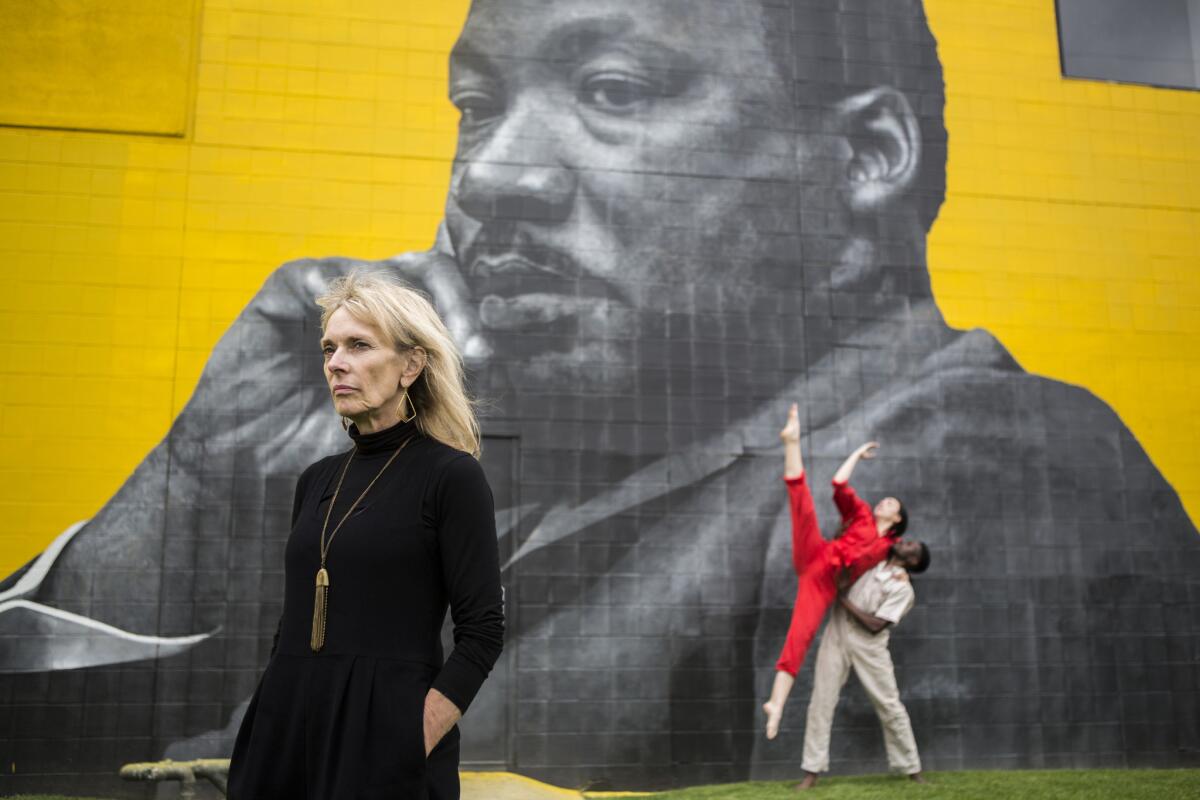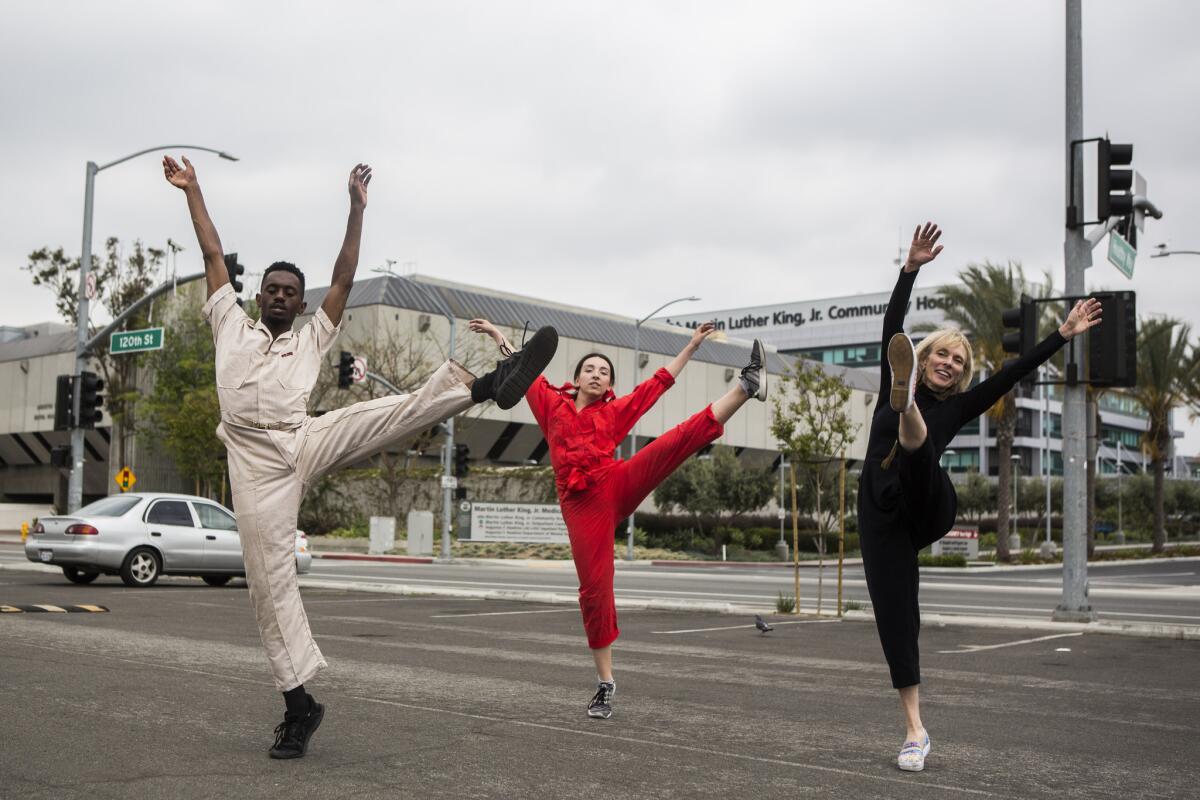Heidi Duckler’s dancers find a most unusual stage: A South L.A. hospital

For 33 years choreographer Heidi Duckler has staged dance performances at far-flung and unexpected locales, from an abandoned Studio City gas station to the Frank Gehry-designed Cabrillo Marine Aquarium in San Pedro.
Her next destination: a hospital campus in South L.A.
Heidi Duckler Dance Theatre will spend two years at and around Charles Drew University of Medicine and Science and the campus of the 3-year-old Martin Luther King Jr. Community Hospital in unincorporated Willowbrook. With a recently announced $75,000 grant from the National Endowment for the Arts, Duckler’s company aims to create not just dance but a more cohesive community.
The project, which starts in August and runs to July 2020, is tentatively titled “Two-Eyed Seeing.” One of the goals is to use the dance-making process to build bonds among medical personnel, patients, students and residents in one of Los Angeles County’s most ethnically diverse and economically challenged neighborhoods. Partnering with government and community groups, Duckler’s company will test the theory that dance can be the glue holding a place together.

Duckler spent almost a year shaping the project, meeting with leaders from the university, the local school district and the community hospital, which replaced the troubled MLK-Harbor after it closed as an acute care hospital in 2007.
“They call it a campus, which is very interesting to me,” Duckler said. “If you think about what a campus implies, it’s that they’re all in the same place, and they all have the same goals or the same rules, and that they share all same desires.”
But research, Duckler said, found that the people who work, go to school, seek care or live in the area really didn’t know who was on the campus or what one another was doing.
One of Duckler’s primary contacts has been Sylvia Drew Ivie, a special assistant to the president of community relations at the university. Ivie wanted to give Duckler a feel for the 52-year-old university, which is named after her father, pioneering scientist and surgeon Charles Drew.
She gave Duckler the lowdown about the university’s programs, its undergraduate academics and the nursing and medical schools. They talked about the diversity of the students and how upon graduation many choose to work in minority communities, which have a shortage of health professionals and resources.
I think that this project will achieve some empathy and mutual understanding for people that are different, but that live in close proximity.
— Dance troupe leader Heidi Duckler
Ivie pointed out that good things are percolating on the campus, such as the return of residency programs for the Drew University medical students at the new MLK hospital.
“People don’t know what goes on in South Los Angeles, first of all,” Ivie said. “If you don’t live here you don’t know. They have no idea about the beauty of this health campus, which is really a great surprise. Here we are, a surprising place with a surprising mission, and here’s someone [Duckler] who’s interested in a surprising cultural mission of bringing it all together. I think it’s a wonderful marriage.”
Duckler has selected an open-air atrium on the university campus for her company to perform. She hopes that community members also will perform and perhaps share a concert with the dance troupe. Duckler’s company also will hold movement workshops with students at the nearby King/Drew Magnet High School of Medicine and Science, teaching a variation of techniques, such as spatial awareness, that the professional dancers use to prepare for concerts in unusual places.
The company expects to hold similar workshops with the residents at the MLK Jr. Recuperative Care Center and the Willowbrook Senior Center, as well as with the university’s nursing students. Duckler said the company’s teaching methods are adapted for each group’s physical capabilities.
As she usually does, the choreographer will share through dance the stories of the people she meets, while also encouraging them to create artwork through which they can share their own stories.
“It’s really important that we work together, that we get to know each other, that we have some mutual understanding,” she said. “We want to have a series of community conversations. Different groups come together to talk about things that are meaningful for them. Through art, they share their stories, they share health and wellness, and why they’re there and why they’re learning.”
The title “Two-Eyed Seeing” is a translation of a Native Canadian word that means gaining wisdom from both indigenous peoples and from Western ways of thinking. It reflects the values that Duckler intends to bring to the project, said David Mack, strategic director of the dance company.
Initially called Collage Dance Theatre, Duckler’s troupe started in the mid-1980s giving one-off performances at nontraditional sites. In recent years, though, the choreographer has engaged in a deeper creative process.
Three years ago, Duckler and her company participated in a similar NEA-funded project at the William Shaw Building in Sun Village, which began as an African American community in the Antelope Valley. For that project, the company spent time with members of the Black Desert Cowboys, the Sun Valley Chamber of Commerce and Ballet Folklorico Etzatlan, among other groups. The professional dancers performed, and then community groups staged an event with the company’s help.
Duckler said that because dance is a method of communicating, one of its side benefits is that it can bring people together, bridging divides. She said that will hold true in Willowbrook.
“I think that this project will achieve some empathy and mutual understanding for people that are different, but that live in close proximity,” Duckler said.
Yolanda Vera, chief executive officer of the Martin Luther King Jr. Outpatient Center, is excited about the project’s possibilities. She said the residents of the Recuperative Care Center will benefit from the workshops.
“Many of them have never been exposed to dance and art,” she said, “and so it is a chance for them to witness beauty.”
She added that she doesn’t want to be “unrealistic” about what dance can accomplish, but, “I still remember an Alvin Ailey performance I went to with my daughter, and it transported us.”
See all of our latest arts news and reviews at latimes.com/arts.
ALSO
‘Soft Power’ at the Ahmanson: Big, bold, overly complicated and spectacularly unique
How ‘My Fair Lady’ and ‘Carousel’ rescued me from the brink of Broadway despair
Miró masterpiece was sold to the highest bidder. It belongs in a museum instead
More to Read
The biggest entertainment stories
Get our big stories about Hollywood, film, television, music, arts, culture and more right in your inbox as soon as they publish.
You may occasionally receive promotional content from the Los Angeles Times.










